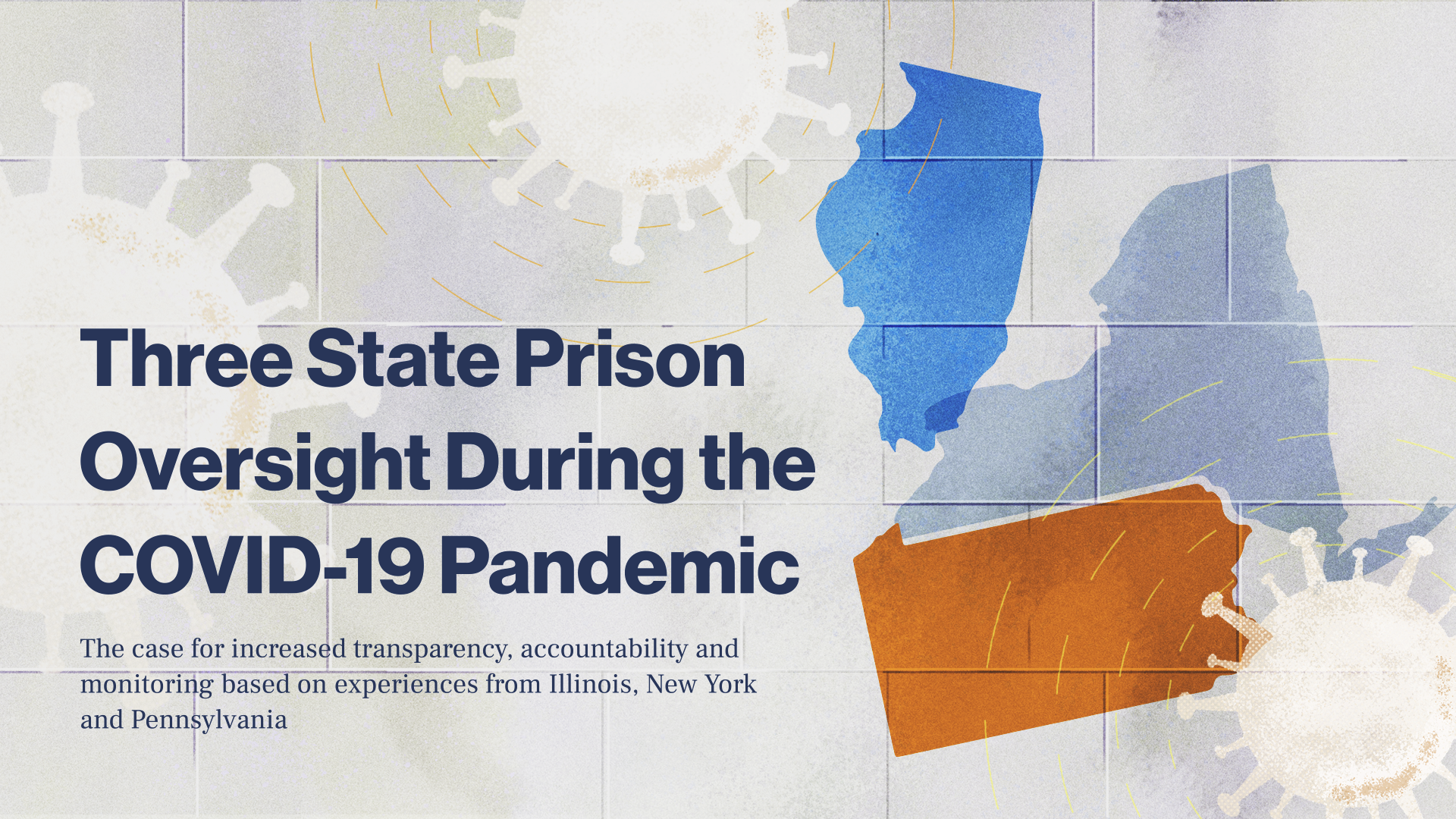Three State Prison Oversight During the COVID-19 Pandemic
CANY, along with the John Howard Association of Illinois and the Pennsylvania Prison Society,
Have produced a collaborative report comparing the responses of the prison systems in three states to the COVID-19 pandemic. Drawing on each organization’s unique access to prisons, the report compares how state prisons in Illinois, New York, and Pennsylvania performed on measures to mitigate illness and death from COVID-19, including reducing prison populations, testing, use of face masks, operational adjustments, communication, and data transparency.
This three-state comparison has yielded multiple examples of practices that could be replicated by the other states to bolster their pandemic response. Despite the enormous challenges posed by the virus and obstacles in gaining access, the report represents a relentless determination across the three organizations to understand, analyze and draw attention to critical challenges and to make concrete recommendations to address them.
The Case for Increased Transparency, Accountability, and Monitoring
Amid a Spike in COVID-19 Cases and Deaths in New York State Prisons in December, New York Must Act on Recommendations to Limit Illness in Prison
New York- NY - Today, the Correctional Association of New York (CANY), the John Howard Association of Illinois (JHA), and the Pennsylvania Prison Society (the Society), the nation’s only non-governmental organizations dedicated to monitoring conditions in state prisons, release a collaborative report comparing the responses of the prison systems in three states to the COVID-19 pandemic. Drawing on each organization’s unique access to prisons, the report compares how state prisons in New York, Illinois, and Pennsylvania performed on measures to mitigate illness and death from COVID-19, including reducing prison populations, testing, use of face masks, operational adjustments, communication, and data transparency. The report covers data through August 2021 and comes as the case count in DOCCS near 600 active COVID infections and three deaths of incarcerated individuals in the first three weeks of December.
As this report is based on information collected in different ways from states that often took different approaches to fight COVID-19, it does not always make like-for-like comparisons. Still, it finds demonstrable links between the different policies and results. For example, Pennsylvania’s $25 vaccination incentive for people in custody is linked to a vaccine uptake rate of 87% in August 2021, compared to a rate of 46% in New York in the same month. Similarly, despite roughly equivalent challenges and budgets, the rate of testing in Illinois far outstripped the other two states. In addition, the report shows how the Illinois Department of Corrections was able to distribute KN95 masks to each incarcerated person on weekly basis, while New York DOCCS distributed cloth masks made by incarcerated workers and only sporadically provided new surgical masks.
This three-state comparison has yielded multiple examples of practices that could be replicated by the other states to bolster their pandemic response. If comparable oversight bodies existed across all 50 states, many more examples of good practice could have been rapidly and practically identified for replication. Unfortunately, there are desperately few such oversight bodies in the United States.
Despite the enormous challenges posed by the virus and obstacles in gaining access, the report represents a relentless determination across the three organizations to understand, analyze and draw attention to critical challenges and to make concrete recommendations to address them. The recommendations speak to the need for a broader culture change within prisons. Evidence of the fundamental importance of transparency of prison practices and information, both to the public and to the incarcerated population, is the overriding theme of this report, explored in the “transparency case studies” and in the section on communication.
For more information on this report, our organizations, and the state of prison oversight in the US please contact:
Correctional Association of New York
Jennifer Scaife
jscaife@correctionalassociation.org
John Howard Association of Illinois
Jennifer Vollen-Katz
jvollen@thejha.org
Pennsylvania Prison Society
Claire Shubik-Richards
cshubik@prisonsociety.org
The Case for Increased Transparency, Accountability, and Monitoring: Key Takeaways from New York
Across multiple components of the crisis and response, New York performed worse than in Illinois or Pennsylvania. Key findings include:
The underlying absence of trust in healthcare providers working in prisons was demonstrated vividly in New York. Only 9.7% of incarcerated people trusted doctors in prison, while 45.5% trusted doctors in general.
The rate of testing in New York was far lower than in Illinois, where the multiple(?) testing rate was four times higher in June 2021, and there was no attempt to replicate the testing of wastewater to mirror the approach applied effectively in Pennsylvania.
The vaccine uptake rate in New York, 46.6% in August 2021, was far lower than in Pennsylvania (87.7%) in the same month. Aside from the absence of financial incentives mentioned above, the disparity can also be partly attributed to the failure to include the incarcerated population of Phase 1B of the vaccination roll out as they were in Illinois and Pennsylvania.
Across multiple monitoring visits conducted by CANY, incarcerated people in New York said that they were afraid to confirm symptoms of COVID-19 as there was no distinction between medical quarantine and punitive isolation.
The DOCCS COVID-19 dashboard received an ‘F’ from UCLA’s grading of similar dashboards across the country. The information provided on the dashboard on COVID-19 and general population information continues to be less detailed than in Illinois or Pennsylvania, making it difficult to assess the point in time infection rates and active cases.

